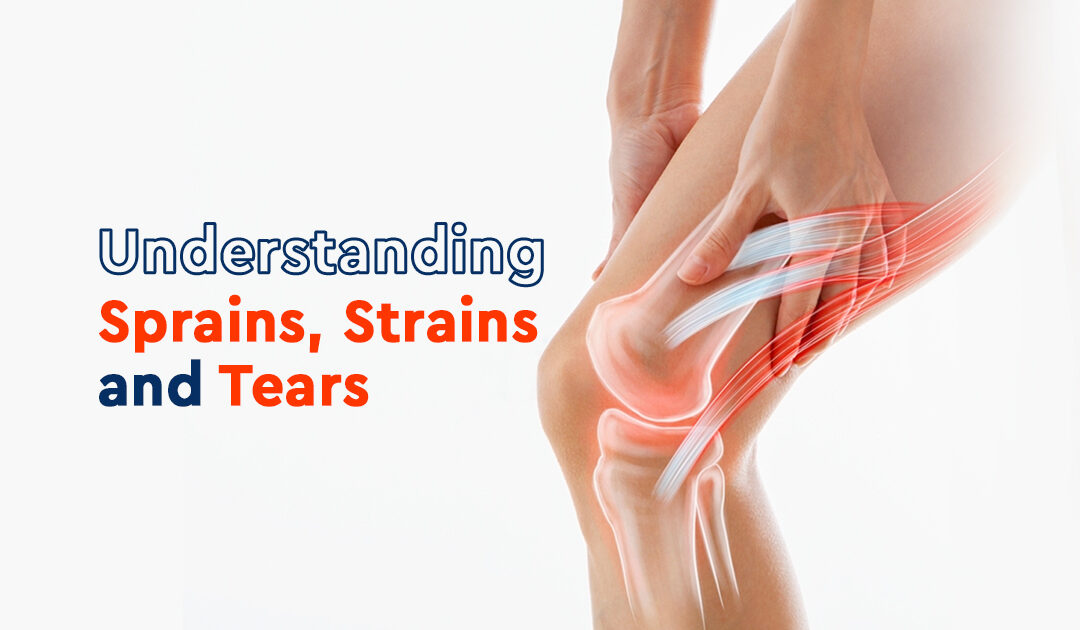Common musculoskeletal injuries like sprains, strains, and tears can prevent you from engaging in your favorite activities and leave you wondering what the differences are and how to cure them. Don’t worry; this blog will help you sort through the symptoms and find your way back to health by unraveling the complexity of these ailments.
What are Sprains?
When a ligament is overextended or partially ripped, a sprain happens. This may occur as a result of an unexpected turn, tumble, or unnatural landing. A sprain can range in severity from minor (grade 1) to severe (grade 3).
- Grade 1 Sprain: Minimal ligament fiber tearing combined with mild overstretching. Mild pain, swelling, and tenderness in the afflicted joint are among the symptoms.
- Grade 2 Sprain: Ligament fibers partially torn in a grade 2 sprain. Moderate discomfort, bruising, edema, and probable joint instability are among the symptoms.
- Grade 3 Sprain: Total ligament rupture. Severe pain, considerable swelling, bruising, and instability are among the symptoms, which frequently make it difficult to put weight on the afflicted joint.
Some common Sprains include:
- Ankle Sprain: A common sports injury that results from rolling the ankle inward, causing the outer ankle ligaments to stretch or tear.
- Wrist Sprain: A fall onto an outstretched hand can cause a wrist sprain, which stretches or tears the ligaments surrounding the wrist joint.
- Knee Sprain: Inducing pain, edema, and instability, a sprain of the ligaments supporting the joint can result from twisting or overextending the knee.
What are Strains?
When a muscle or the tendon that connects it is overextended or damaged, a strain happens. Repetitive motions, incorrect form when lifting large objects, or abrupt, violent exercise can all contribute to this. As with sprains, the severity of strains can vary:
- Grade 1 Strain: Muscle fiber microtears are a sign of grade 1 strain. Mild discomfort, soreness, and a little muscle weakness are among the symptoms.
- Grade 2 Strain: Muscle fibers partially torn in a grade 2 strain. Moderate discomfort, bruising, swelling, and apparent muscle weakening are among the symptoms.
- Grade 3 Strain: Total rupture of a tendon or muscle. Severe pain, bruising, edema, and immobility of the afflicted muscle group are among the symptoms.
Some common Strains include:
- Lower Back Strain: Pain and tightness can be caused by putting too much weight on your lower back or by employing inappropriate lifting technique.
- Hamstring Strain: A strain can result from overstretching or by firmly contracting the muscles that run the length of the leg.
- Rotator Cuff Strain: This condition, which is caused by repetitive overhead motions, affects the tendons and muscles in the shoulder joint.
What are Tears?
Ruptures of ligaments, tendons, or muscles are called tears. They frequently result from severe force or trauma and need to be treated medically in order to heal properly. In addition to being comparable to severe sprains or strains, symptoms of a tear can also include:
- at the moment of injury, a popping or snapping sound
- notable deterioration of function and strength in the affected area
- Deformity or obvious bruises in the area
Some common types of Tears include Ligament Tears and Tendon Tears with multiple types under each of them.
